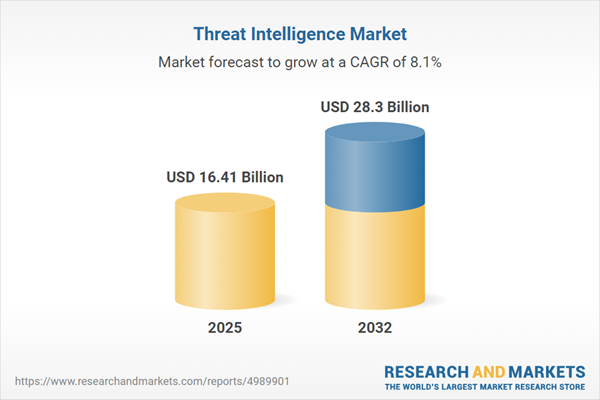Speak directly to the analyst to clarify any post sales queries you may have.
Enterprises face mounting challenges as digital transformation accelerates and security complexities grow. The threat intelligence market empowers senior leaders to navigate risk, maintain operational continuity, and uphold regulatory commitments across evolving threat environments.
Market Snapshot: Threat Intelligence Market Overview
The threat intelligence market continues its steady global expansion, reflecting increased adoption of digital tools and escalating security requirements across both public and private sectors. In 2024, market size stands at USD 15.15 billion and is projected to reach USD 16.41 billion by 2025, with forecasts extending to USD 28.30 billion by 2032. A compound annual growth rate of 8.11% underscores market momentum, driven by enterprise investments in advanced analytics, a pervasive need for compliance, and constant innovations in security technology. Organizations adapt their security strategies based on unique operational profiles, regulatory climates, and the shifting nature of cyber threats, with leading vendors prioritizing agility and resilience within risk management frameworks.
Scope & Segmentation of the Threat Intelligence Market
- Component: Managed services, professional consulting, and dedicated threat intelligence platforms strengthen IT infrastructures, support dynamic operations, and help minimize risk during technology transitions.
- Threat Intelligence Type: Operational, strategic, and tactical intelligence solutions provide critical detection and response advantages to sectors such as finance, healthcare, and government.
- Deployment Mode: Both cloud-based and on-premise deployments offer organizations agility and the ability to tailor security frameworks to compliance protocols.
- Application: Specialized offerings address banking, IT, retail, telecommunications, healthcare, and government, aligning solutions to sector-driven compliance and business demands.
- Organization Size: Scalable platforms and solutions cater to enterprises of all sizes, ensuring that diverse performance and operational needs are met, from small businesses to multinational corporations.
- Region: The market delivers tailored offerings for the Americas, EMEA, and Asia-Pacific, each addressing unique regulatory expectations and security priorities for local and multi-site enterprises.
Industry leaders such as International Business Machines Corporation, Cisco Systems, Palo Alto Networks, CrowdStrike, and Recorded Future deliver threat intelligence designed for robust, scalable enterprise applications. Companies such as Intel 471, Trend Micro, Google, Mandiant, McAfee, and Musarubra US focus on analytics, automation, and incident response, equipping organizations with capabilities to address new regulatory challenges and diverse threat vectors.
Key Takeaways for Senior Decision-Makers
- Advanced threat intelligence is central to effective enterprise risk management, allowing organizations to address evolving compliance requirements and shifting threat profiles with confidence.
- Real-time, actionable insights from threat intelligence tools support leaders in making informed strategic decisions as regulatory environments change globally.
- Flexible deployment options help organizations modernize securely, align security postures to industry standards, and facilitate effective governance.
- Open, modular threat intelligence platforms enable rapid responses to new risks, strengthening operational resilience across the enterprise.
- Sector-specific and regionally adapted solutions ensure organizations meet local regulations and performance needs, which is critical for organizations in highly regulated or sensitive industries.
- Ongoing investment in analytics, automation, and matured security operations enables leadership teams to enhance protection and refine risk management strategies for the future.
Tariff Impact
Recent changes in tariffs and international trade policies, particularly in the U.S., have led organizations to adjust procurement strategies to ensure supply chain integrity. Enterprises are reinforcing supply networks, executing localized agreements, and focusing on data sovereignty to meet rising compliance requirements prompted by a changing trade environment.
Methodology & Data Sources
The analysis draws on interviews with security executives, comprehensive secondary research, and expert sector input. Robust statistical methods and data triangulation guarantee relevance and accuracy for executive-level decision-making within the threat intelligence market.
Threat Intelligence Market: Why This Report Matters
- This report provides senior leaders with critical intelligence, enabling strategic investment and compliance planning amid regulatory flux.
- Sector- and region-focused insights support effective benchmarking and vendor selection aligned to organizational objectives.
- Proactive recommendations empower decision-makers to drive risk management and position their organizations for continued resilience.
Conclusion
Threat intelligence adoption is central to securing business continuity and operational resilience. This report delivers actionable guidance tailored for the evolving security and compliance demands confronting enterprise organizations.
Additional Product Information:
- Purchase of this report includes 1 year online access with quarterly updates.
- This report can be updated on request. Please contact our Customer Experience team using the Ask a Question widget on our website.
Table of Contents
3. Executive Summary
4. Market Overview
7. Cumulative Impact of Artificial Intelligence 2025
Companies Mentioned
The companies profiled in this Threat Intelligence market report include:- International Business Machines Corporation
- Cisco Systems, Inc.
- Palo Alto Networks, Inc.
- CrowdStrike, Inc.
- Recorded Future, Inc.
- Intel 471, Inc.
- Trend Micro Incorporated
- Google LLC
- Mandiant
- McAfee, LLC
- Musarubra US LLC
Table Information
| Report Attribute | Details |
|---|---|
| No. of Pages | 183 |
| Published | October 2025 |
| Forecast Period | 2025 - 2032 |
| Estimated Market Value ( USD | $ 16.41 Billion |
| Forecasted Market Value ( USD | $ 28.3 Billion |
| Compound Annual Growth Rate | 8.1% |
| Regions Covered | Global |
| No. of Companies Mentioned | 12 |









